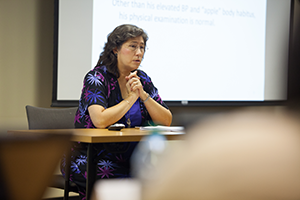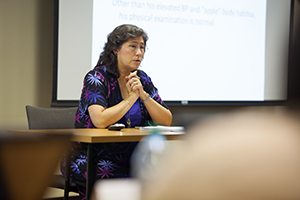Behind the wheel


The American Geriatrics Society and the National Highway Traffic Safety Administration has released the third edition of the Clinician's Guide to Assessing and Counseling Older Drivers . FSU College of Medicine Professor of Geriatrics Alice Pomidor serves as chair of the guide’s editorial board.
"Physicians can use the Clinician’s Guide from the perspective of helping their patients maintain essential driving abilities early, to help their driving life expectancy match the patient’s lifespan," Pomidor said. "When we establish ourselves as trying to support the patient from the beginning, most older adults can begin to tell when they need to restrict their driving, or are becoming unsafe. Most physicians in Florida do talk to their older adult patients about the issue of driving, but it often does not come up until it’s too late to help.
"The Clinician’s Guide gives physicians the tools they need at each step to perform an organized, brief, office-based assessment that provides the information needed to determine whether an older adult is at risk for unsafe driving. There are helpful suggestions on how to approach the 'tune-up' of medical conditions and problems to support driving skills for as long as possible; when to refer for formal driving rehabilitation assessment; and how to approach the conversation with the older adult and their caregivers. Specific assessment forms, patient-care handouts, and contact information for finding alternative transportation options ,and each state’s licensing authority are also included."
PRESS RELEASE FROM THE AMERICAN GERIATRICS SOCIETY:
Media Contact:
Dan Trucil
212-308-1414, ext. 329
dtrucil@americangeriatrics.org
New York (Feb. 16, 2016)—A newly updated guide from the American Geriatrics Society (AGS) and the National Highway Traffic Safety Administration (NHTSA) is putting healthcare professionals on the road to success for assessing and counseling older drivers. With older adults accounting for 10 percent of all people injured in traffic crashes annually and 17 percent of annual traffic fatalities, the Clinician’s Guide to Assessing and Counseling Older Drivers (3rd Edition) translates research findings and public health initiatives into practical, person-centered advice for safely navigating the open road.
“For all of us, but for Baby Boomers especially, driving is more than just a national pastime and a means for transportation. It’s a reflection of independence, mobility, and freedom,” explains Alice Pomidor, M.D., MPH, AGSF, chair of the editorial board that developed the AGS-NHTSA guide. “The main goal of this guide is to help healthcare professionals promote health, independence, and quality of life by preventing crashes and injuries.”
Added Nancy E. Lundebjerg, MPA, AGS CEO: “This guide reflects the fact that many individuals play a role in older adult well-being, and that expert-authored tools, tips, and recommendations can help all healthcare professionals support high-quality, person-centered care in a key focus area: driver safety.”
Reviewed and edited by an interprofessional board of physicians, nurses, social workers, occupational therapists, and pharmacists, the updated guide walks through key issues, opportunities, and challenges faced by older drivers, their healthcare professionals, and their caregivers. Key areas of emphasis include:
- Determining when an older person may be at an increased risk for unsafe driving. The AGS-NHTSA guide highlights certain “red lights” that clinicians should look for, such as impaired vision or hearing.
- Recognizing medical conditions, functional deficits, and medications that may affect driver safety. Increased longevity in the U.S. population coupled with the number of health conditions older adults manage mean that many older individuals may outlive their ability to drive safely.
- Understanding how to screen and assess functional abilities for driving. Motor skills, sensory perception, vision, and cognition are all important to driving. However, they may not be equally important for a particular older adult: one area of function may warrant greater attention than another on a case-by-case basis.
- Advising older adults about transitioning from driving. Proactively screening frail older adults for driving safety means knowing when to make strategic recommendations and planning for driving retirement beforehand.
- Considering ethical and legal issues affecting older drivers. Laws, regulations, and policies on driving vary not only by state but also by local jurisdiction.
- Meeting the future transportation needs of older adults. Coordination among clinicians, licensing agencies, and relevant state/community entities can help older adults and caregivers become aware of resources once independent driving is no longer an option.
The full guide and collateral tools will be available on GeriatricsCareOnline.org, the online home for AGS resources. Public education materials also will be released by the Health in Aging Foundation on HealthinAging.org.

